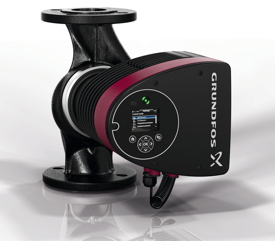Pumping out energy savings

Building-services systems with pumps that are more than about five years old could probably achieve significant cost-saving and operational benefits by replacing pumps. Glynn Williams of Grundfos Pumps gives an insight.
Pumps are at the very heart of any facility, and day in and day out they are central to supporting operational systems as well as maintaining the internal climate and water supply demands that helps to keep businesses running optimally.
In terms of the costs associated with this, when you view the whole life-cycle cost relating to a pump or pumping system, the purchase price is a much smaller part of the equation than you would think. In fact, by far the most significant factor relating to the pumps is associated with their operational costs.
What this means is that in reality, 85% of the total life-cycle cost of any pump system is attributable to the energy that is required to run the pumps. However, on a positive note, this does mean that pump systems can offer great opportunities to save money, especially those that are over five years old or where there has been any change in usage since the original system was specified.
To establish the current operation of any pump system Grundfos Pumps can undertake an energy check. This is a quick and effective way to establish current use, which is then reported back via a comprehensive feedback system that will allow companies to assess their options. These checks will register information on pump types, age, flow, head and power usage. The inspection requires no downtime.
Undertaking an energy check like this will offer the opportunity to identify where significant savings can be achieved, not only in terms of operational costs, but also to help businesses comply with energy-saving regulations as well as helping towards corporate environmental and CRM goals that are often closely associated with a reduced carbon footprint.
Looking at the wider picture in terms of the benefits that an energy check can deliver, these fall into three categories:
Financial benefits
These checks will typically demonstrate savings of 30 to 50% in energy costs that can be achieved through changing or upgrading some/all pumps. With older systems, or where there has been a significant change in use, savings can be much higher. This therefore means that there is frequently a short pay-back time — typically one to five years.
Another of the benefits is that there is a reduced risk to a business in terms of offering some protection from increasing energy prices. Plus, with a more efficient system with newer equipment, there are reduced operational and maintenance costs.
Environmental benefits
Many companies today have set themselves environmental goals. Therefore the typical 30% reduction of CO2 emissions that can be achieved from a pump upgrade will help to impact on the achievement of corporate environmental goals and support a greener corporate image.
Fitting new-generation energy-efficient pumps, such as members of the Grundfos Magna3 family, helps a company to comply with number of the energy regulations that exist, as well as counting towards a range of other measures — such as BREEAM rating.
Operational benefits
The third benefit is possibly less obvious, but new and upgraded pumps contribute towards the overall reliable operation of a facility. This is something that is important but which in certain operational instances can be vital — as a better pump means a low failure rate, which means reduced down-time and reduced repair costs.
Another operational benefit is a reduced risk of obsolescence, which can be a very important consideration when the pumps form part of a manufacturing process, for example.

The comprehensive report that is prepared following an energy check will show hard facts about the current installation and current operational costs. The report will include an overview on the potential savings that could be reached through upgrading all or some of the system to a new energy-efficient solution.
Reports include details such as the following.
• Electricity savings (kWh/a)
• Savings on the electricity bill
• Other savings — such as maintenance, repairs etc.
• Cost of new pump investment
• Pay-back time (years)
• Reduction in CO2 emissions (t/a)
• Life-cycle analysis of pump installation.
Besides these specific points, a report will also contain additional recommendations that will be specific to the energy check and a step-by-step implementation plan.
Here are a few examples on how energy checks have worked in practice
A 700+ bed hospital in the north west of England wanted to establish its current pump set-up. An energy check showed that if a number of end suction and in-line pumps were exchanged for more efficient models, a huge saving of 429 645 kWh per year was indicated. The return on investment in this instance was 1.5 years
Grundfos undertook an energy check survey on a large hotel in the south of England. The results indicated that substantial savings of about 787 573 kWh per year could be achieved with a payback period of two years by replacing the existing pumps with variable-speed efficient options.
Glynne Williams is director of sales for commercial building services with Grundfos Pumps.







